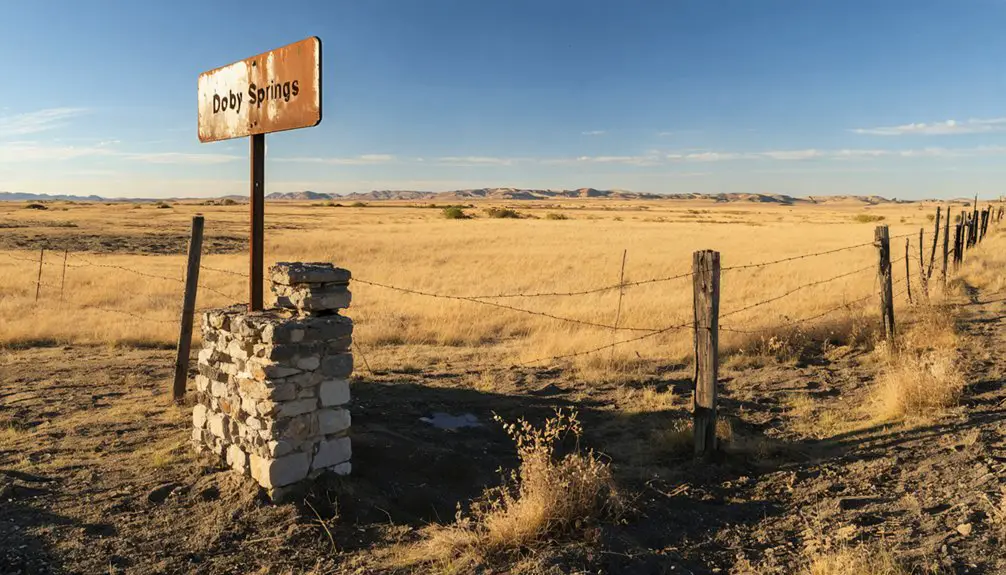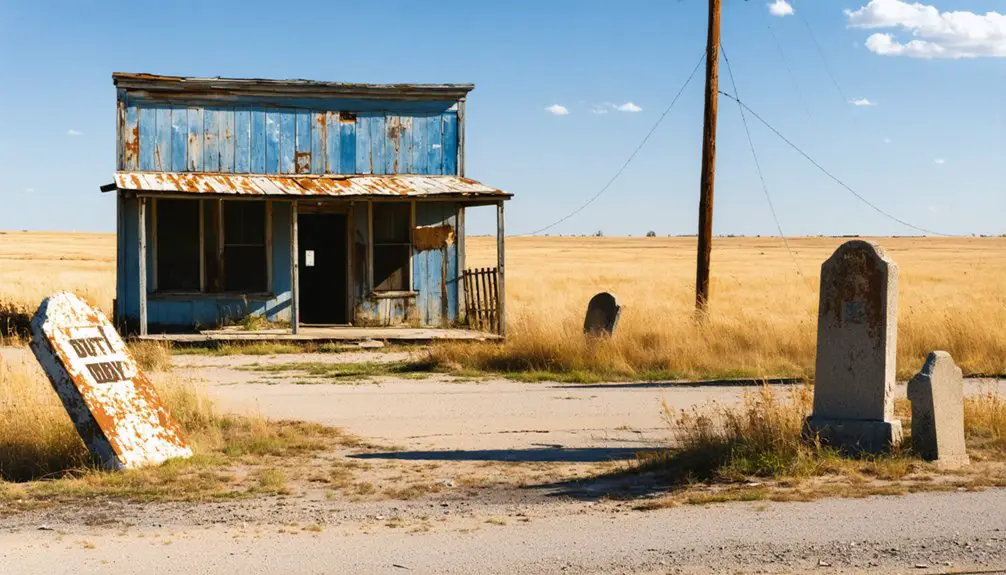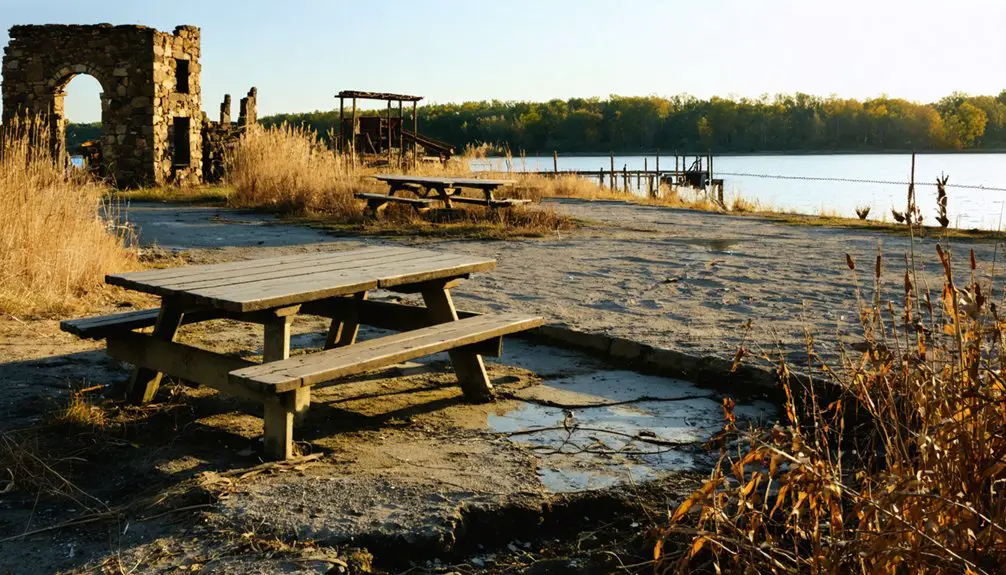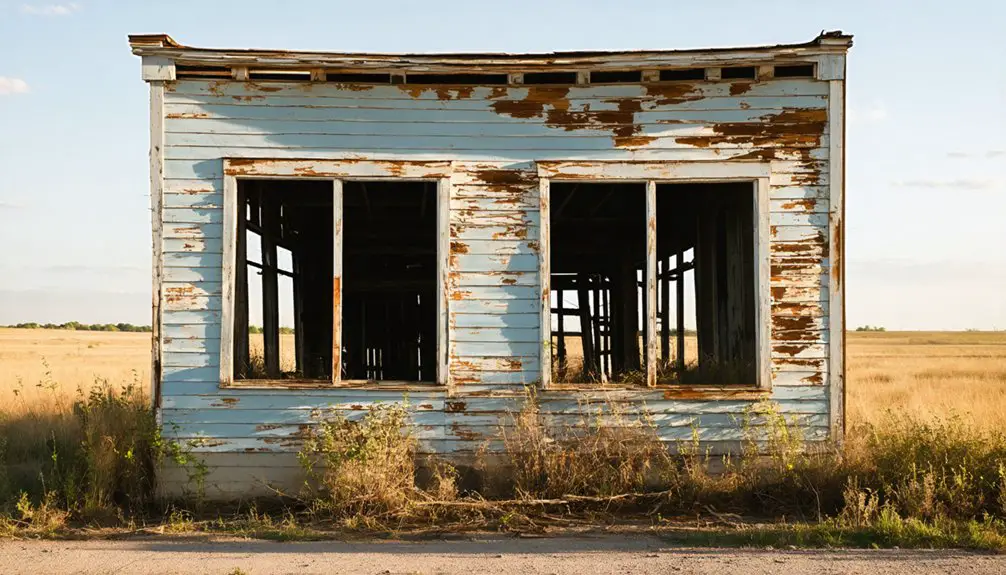You’ll find Doby Springs about 8 miles west of Buffalo in Harper County, Oklahoma, where natural springs once drew hopeful settlers in 1903. Initially named Ballaire, the town renamed itself after prominent landowner C.C. Doby in 1908 but lost a critical county seat election that same year. By 1922, the post office closed and residents drifted away. Today, the ghost town‘s legacy lives on through a recreational lake and park, with hidden stories scattered across the prairie landscape.
Key Takeaways
- Doby Springs transformed from a frontier settlement into a ghost town after losing the 1908 county seat election to Buffalo.
- The town’s post office closed in 1922, marking a crucial turning point in its decline from an active community.
- Located 8 miles west of Buffalo, Oklahoma, the former town site now serves as a recreational lake and water source.
- C.C. Doby’s influence as principal landowner shaped the town’s early development before its eventual abandonment.
- The ghost town’s legacy continues through its park system, offering camping, fishing, and historical educational opportunities.
Origins and Early Settlement (1903-1908)
When the post office opened on June 27, 1903, under the name Ballaire, it marked the official beginning of what would become Doby Springs, Oklahoma.
You’ll find this early settlement nestled about eight miles west of Buffalo, where natural springs provided a promising foundation for community growth.
C.C. Doby owned the land where settlers established their dreams of building a thriving town in Harper County’s plains.
The small town charm remained a defining characteristic of the community during its early years.
The rural challenges of attracting enough residents and developing infrastructure didn’t deter these pioneering spirits. Like many of Oklahoma’s estimated two thousand ghost towns, Doby Springs faced the difficult task of sustaining its population against mounting odds.
The pioneering spirit persevered despite rural isolation and development hurdles, showing remarkable determination in building their frontier community.
On January 13, 1908, they renamed the town Doby Springs in honor of the landowner, signaling their commitment to creating a permanent home.
While farming and ranching dominated the local economy, the town’s leaders set their sights on greater ambitions, including a bid for the county seat.
The Man Behind the Name: C.C. Doby
C.C. Doby’s influence on Oklahoma Territory‘s development centered on his strategic land ownership, which later became the foundation for Doby Springs.
You’ll find his name immortalized in the town’s 1908 post office renaming from Ballaire to Doby Springs, marking his status as the principal landowner and pioneer of the settlement.
While detailed records of C.C. Doby‘s personal life remain scarce, his legacy as a territorial land pioneer lives on through the ghost town and park that still bear his name in Harper County. Like other historical figures sharing his surname, documentation of his early life requires careful research to distinguish from others. Today, researchers can access historical records on FamilySearch.org to piece together details about early Oklahoma pioneers.
Early Land Claims Pioneer
As Oklahoma’s frontier history unfolded in the late 19th century, Christopher Columbus Doby emerged as one of the most influential pioneers in Harper County’s development.
You’ll find his story woven into the fabric of the Cherokee Outlet Opening of 1893, where he strategically staked his claim in what would become the heart of northwest Oklahoma.
The area’s strategic location near two major rivers, the Cimarron and Beaver, made it an attractive settlement choice.
The area’s heavily wooded springs provided a natural gathering place that had long been used by Indians and cowboys before settlement.
Facing pioneer challenges that included establishing trade routes and maneuvering relationships with Native Americans, Doby’s land claim strategies proved remarkably successful.
He settled approximately nine miles west of present-day Buffalo, where he’d help establish a community that bore his name.
His vision and determination contributed to the region’s growth, as Doby Springs evolved into a significant settlement that nearly became the county seat, losing by just 111 votes in 1908.
Oklahoma Territory Influence
Through his extensive land holdings and influential presence, Christopher Columbus Doby left an indelible mark on Oklahoma Territory’s development in Harper County.
Much like Caddo County’s early territorial land lottery of 1901, settlers were eager to establish new towns and communities in Harper County.
You’ll find his legacy most prominently in the fierce territorial competition of 1908, when Doby Springs vied to become the county seat. Though his town lost by just 111 votes to Buffalo, Doby’s land ownership shaped the region’s early development and mapping.
The impact of C.C. Doby’s presence extended beyond mere property lines. His namesake settlement, changing from Ballaire to Doby Springs in 1908, reflected the common territorial practice of honoring significant landowners.
While the town’s dreams of becoming an administrative center faded, Doby’s influence lives on through Doby Springs Park and Lake, which still serves Buffalo’s water needs today.
Battle for County Seat Status

In 1908, Doby Springs and Buffalo engaged in a fierce political battle for Harper County’s seat designation, a contest that would ultimately determine the region’s administrative center.
You’ll find that this political rivalry gripped the attention of locals, as both towns understood the high stakes involved – the winner would secure government offices and regional prominence, while the loser risked fading into obscurity.
The competition mirrored the intense territorial conflicts seen during the Civil War, where towns often became targets for guerrilla warfare tactics.
When the votes were tallied, Buffalo emerged victorious by a slim margin of 111 votes.
This crushing defeat sealed Doby Springs’ fate. Like many small Oklahoma towns that lost county seat competitions during this era, Doby Springs couldn’t maintain its significance.
Geographic Features and Location
You’ll find Doby Springs nestled in Harper County, Oklahoma at 36°50′17″N 99°46′55″W, about 8 miles west of Buffalo and 2 miles north of Highway 64.
The town’s original settlement grew around essential water resources, including a lake that still serves Buffalo’s municipal needs and a fishing pond that attracts visitors today. Local temperatures typically range from the 30s to 90s throughout the year.
The flat High Plains terrain surrounding Doby Springs features scattered trees and rolling canyons, creating a distinctive landscape that’s characteristic of northern Oklahoma’s open spaces.
Coordinates and County Position
Located at precisely 36.8292° N and -99.7743° W, Doby Springs rests at an elevation of 1,998 feet within Harper County, Oklahoma.
You’ll find this ghost town in the northwestern region of the state, where it holds geographic significance as part of the county’s rich historical landscape. The site’s open location code (8682R6HG+M7) helps you pinpoint its exact position within the county’s 1,041 square miles of mainly flat terrain.
Harper County, formed in 1907 from Woodward County’s northwestern section, maintains its rural character with a sparse population density of just 3.1 persons per square mile. Several notable reservoirs can be found within a 5-mile radius of the area.
While Buffalo serves as the county seat, the community dynamics of Doby Springs reflect its current status as a ghost town, though it’s conveniently situated near the larger town of Laverne.
Water Resources and Terrain
While Buffalo Creek meanders through the heart of Doby Springs at 1,998 feet above sea level, the surrounding terrain stretches out in characteristic Oklahoma prairie fashion with gently rolling grasslands and scattered trees.
You’ll find terrain features that blend seamlessly with the region’s sand sage and yucca grasslands, creating an ideal setting for outdoor adventure.
- Natural springs that once drew settlers still influence the local ecosystem
- Buffalo Creek provides a crucial water source at 1,930 feet elevation
- Flat, open spaces perfect for camping and exploration
- Mixed grassland environment with scattered trees for shade
Water availability from both the creek and historic springs has shaped this landscape, making it a unique spot where you can experience the raw beauty of northern Oklahoma’s prairie environment while enjoying easy access to camping and hiking opportunities.
From Bustling Town to Abandoned Plains

Despite its promising beginnings in 1903, Doby Springs’ transformation from a bustling frontier settlement to an abandoned plain hinged on a single pivotal moment – the loss of the 1908 county seat election to Buffalo by just 111 votes.
The defeat triggered dramatic community dynamics, as residents and businesses gradually drifted away from the once-hopeful town. You’ll find that economic shifts hit hard and fast – without the guaranteed governmental functions a county seat would’ve provided, Doby Springs couldn’t sustain itself against growing competition from Buffalo.
Without the stability of county seat status, Doby Springs withered as its economic lifeblood flowed steadily toward Buffalo’s growing influence.
By 1922, even the post office – the town’s original cornerstone – had shuttered its doors.
The land where hopeful settlers once built their dreams now serves a different purpose as a recreational lake and water source for the very town that sealed its fate.
The Legacy of a Lost Community
The ghost town of Doby Springs lives on through a rich tapestry of historical significance and modern-day utility.
You’ll find its enduring legacy in both the political struggles that shaped Harper County and the transformation of its landscape into an essential resource for modern residents.
While the town’s physical structures have vanished, its community identity remains preserved through:
- A park and lake system that now supplies water to Buffalo
- The dramatic story of its 1908 county seat battle, lost by just 111 votes
- Local folklore and educational materials that keep pioneer stories alive
- The site’s evolution from settlement to environmental preserve
Today, you can experience Doby Springs’ legacy through its natural springs and parkland, where the spirit of this once-hopeful community continues to serve future generations.
Modern Day Park and Lake Development

Building upon its historic foundations, modern-day Doby Springs has transformed into a vibrant recreational destination centered around its newly developed park and lake system.
Through careful recreational planning, you’ll find walking trails weaving through preserved ruins, interpretive signage sharing the town’s story, and camping facilities that blend seamlessly with the natural landscape.
The creation of Doby Springs Lake has revolutionized the area’s eco tourism potential. You can enjoy fishing, boating, and wildlife viewing while appreciating how the lake has enhanced local ecosystems.
The park’s development prioritizes environmental conservation, maintaining native vegetation and protecting wildlife habitats.
Whether you’re interested in history, outdoor adventure, or simply connecting with nature, you’ll discover that this thoughtfully managed park system offers a perfect balance of preservation and recreation, supporting both the local economy and community well-being.
Historical Significance in Oklahoma’s Settlement Era
During Oklahoma’s vibrant settlement era, Doby Springs emerged as a promising frontier town in 1903, reflecting the territory’s rapid transformation before statehood.
Like many settlements of its time, the town’s fate hinged on securing political prominence and economic stability.
Four key factors shaped Doby Springs’ role in Oklahoma’s settlement:
- Strategic location near military and cattle trails made it crucial for travelers
- Natural springs provided essential water resources in the arid region
- Settlement patterns followed land ownership, with C.C. Doby’s influence driving development
- Economic struggles intensified after losing the county seat battle
You’ll find Doby Springs’ story mirrors countless other frontier towns that briefly flourished during Oklahoma’s settlement rush, only to fade as political and economic forces reshaped the landscape.
Frequently Asked Questions
What Was the Peak Population of Doby Springs During Its Active Years?
Picture a small frontier outpost – you’d find the peak demographics never officially recorded, though historical significance suggests around 200-300 residents at most during its heyday before 1922 when the post office closed.
Were There Any Notable Businesses or Industries Operating in Doby Springs?
You won’t find major industries in Doby Springs history. Local commerce centered on basic services like the post office, general stores, and agricultural trade supporting travelers and settlers along the cattle trail.
What Caused the Lake to Be Created at the Former Townsite?
You’ll find the lake formation came about when Buffalo needed a reliable water supply, transforming the historical significance of this abandoned townsite into a practical municipal reservoir.
Did Any Original Buildings From Doby Springs Survive Until Modern Times?
You won’t find any historical preservation or architectural remnants from the original Doby Springs buildings today. Unlike other ghost towns, the site’s complete conversion to a park erased all structural traces.
What Native American Tribes Inhabited the Area Before Doby Springs’ Establishment?
You’ll find the native tribes of Wichita, Kiowa, and Comanche once roamed this area, sharing the cultural heritage of the Southern Plains before European settlement pushed them from their ancestral lands.
References
- https://en.wikipedia.org/wiki/List_of_ghost_towns_in_Oklahoma
- https://en.wikipedia.org/wiki/Doby_Springs
- https://kids.kiddle.co/List_of_ghost_towns_in_Oklahoma
- https://okgenweb.net/~okharper/library/towns/dobysprings.html
- https://www.loquis.com/en/loquis/6757526/Doby+Springs+Oklahoma
- https://kids.kiddle.co/Doby_Springs
- https://www.geotab.com/ghost-towns/
- https://en.wikipedia.org/wiki/Doby
- https://ancestors.familysearch.org/en/L84C-ZMS/william-cornelius-doby-1904-1974
- https://www.dobyfamilytree.com/getperson.php?personID=I232339733506&tree=doby



